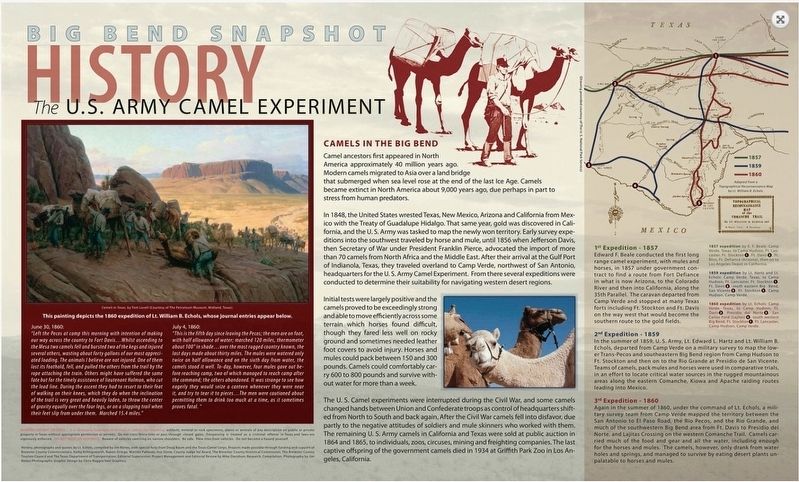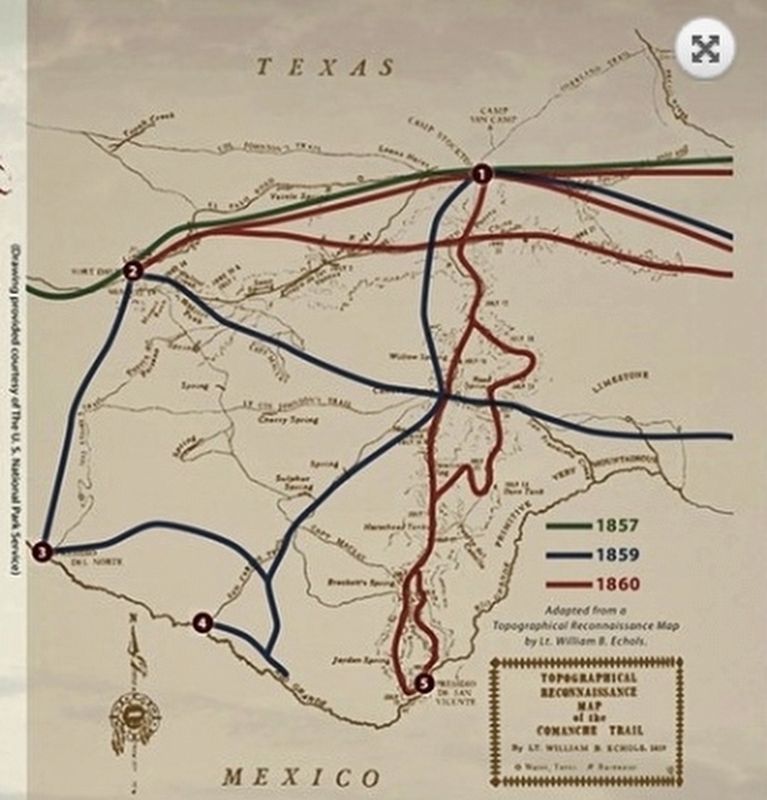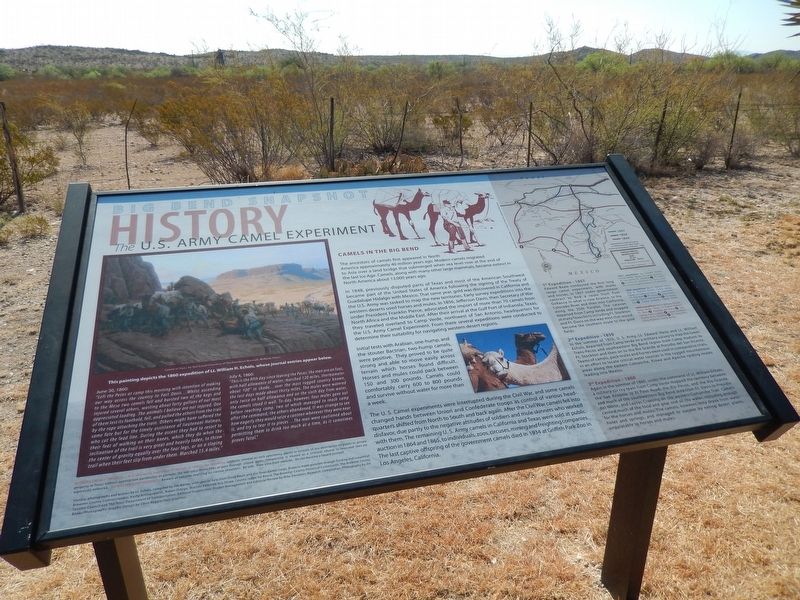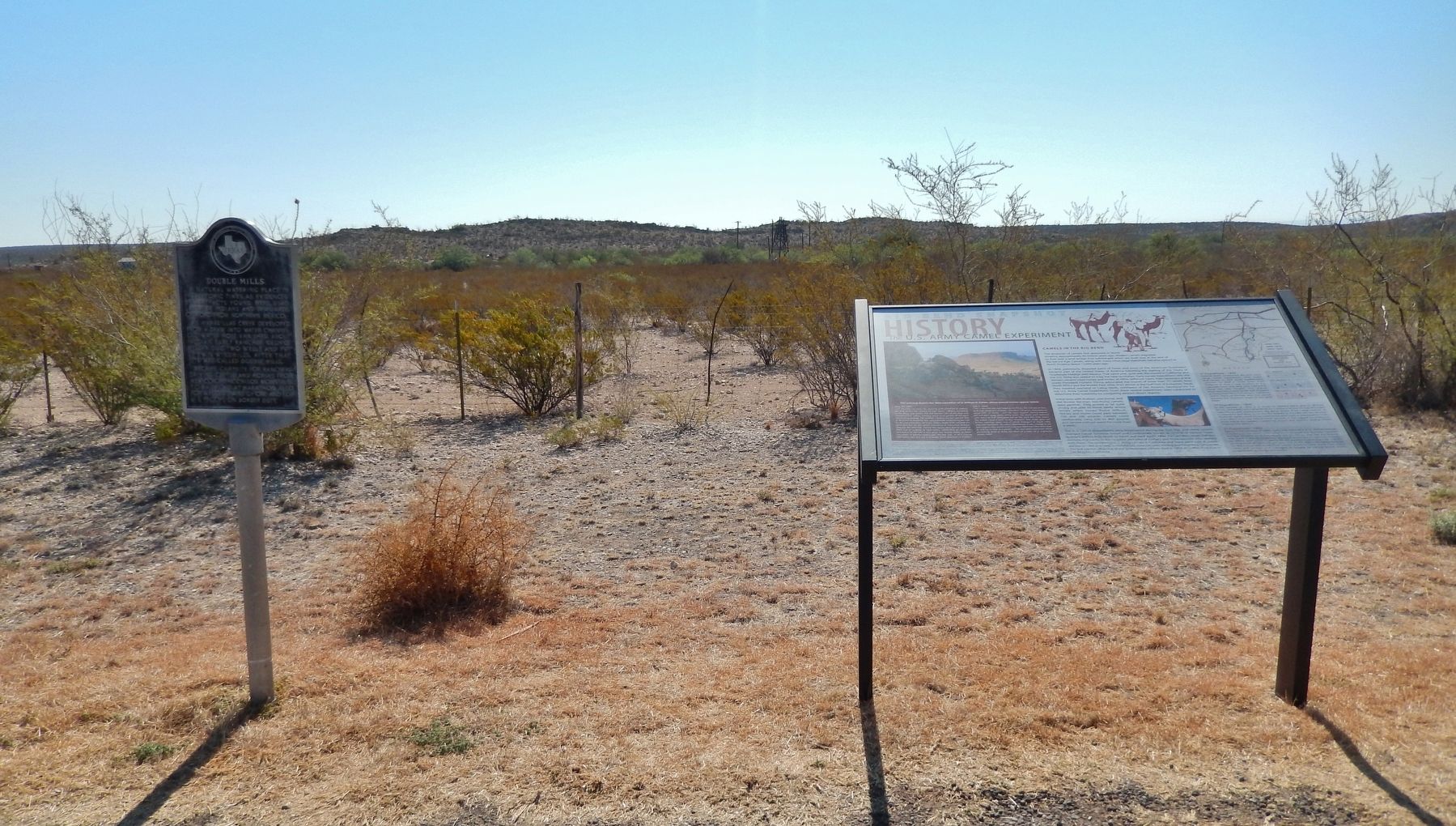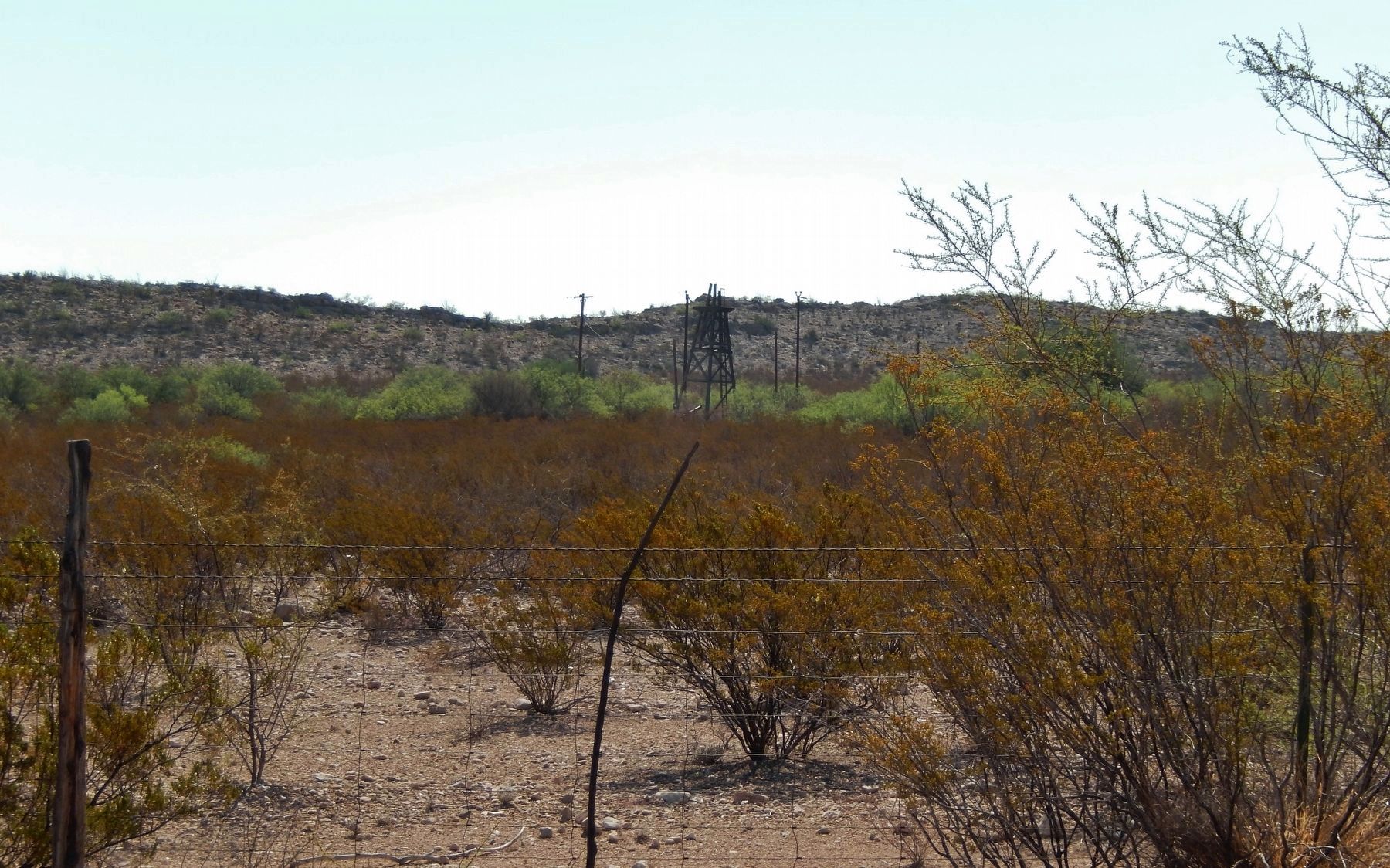Near Marathon in Brewster County, Texas — The American South (West South Central)
The U.S. Army Camel Experiment
Camels in the Big Bend
Camel ancestors first appeared in North America approximately 40 million years ago. Modern camels migrated to Asia over a land bridge that submerged when sea level rose at the end of the last Ice Age. Camels became extinct in North America about 9,000 years ago, due perhaps in part to stress from human predators.
In 1848, the United States wrested Texas, New Mexico, Arizona and California from Mexico with the Treaty of Guadalupe Hidalgo. That same year, gold was discovered in California, and the U.S. Army was tasked to map the newly won territory. Early survey expeditions into the southwest traveled by horse and mule, until 1886 when Jefferson Davis, then Secretary of War under President Franklin Pierce, advocated the import of more than 70 camels from North Africa and the Middle East. After their arrival at the Gulf Port of Indianola, Texas, they traveled overland to Camp Verde, northwest of San Antonio, headquarters for the U.S. Army Camel Experiment. From there several expeditions were conducted to determine their suitability for navigating western desert regions.
Initial tests were largely positive and the camels proved to be exceedingly strong and able to move efficiently across some terrain which horses found difficult, though they fared less well on rocky ground and sometimes needed leather foot covers to avoid injury. Horses and mules could pack between 150 and 300 pounds. Camels could comfortably carry 600 to 800 pounds and survive without water for more than a week.
The U.S. Camel experiments were interrupted during the Civil War, and some camels changed hands between Union and Confederate troops as control of headquarters shifted from North to South and back again. After the Civil War camels fell into disfavor, due partly to the negative attitudes of soldiers and mule skinners who worked with them. The remaining U.S. Army camels in California and Texas were sold at public auction in 1864 and 1868, to individuals, zoos, circuses, mining and freighting companies. The last captive offspring of the government camels died in 1934 at Griffith Park Zoo in Los Angeles, California.
(sidebar)
1st Expedition – 1857
Edward F. Beale conducted the first long range camel experiment with mules and horses, in 1857 under government contract to find a route from Fort Defiance in what is now Arizona, to the Colorado River and then into California, along the 35th Parallel. The caravan departed from Camp Verde and stopped at many Texas Forts including Ft. Stockton and Ft. Davis on the way west that would become the southern route to the gold fields.
2nd Expedition – 1859
In
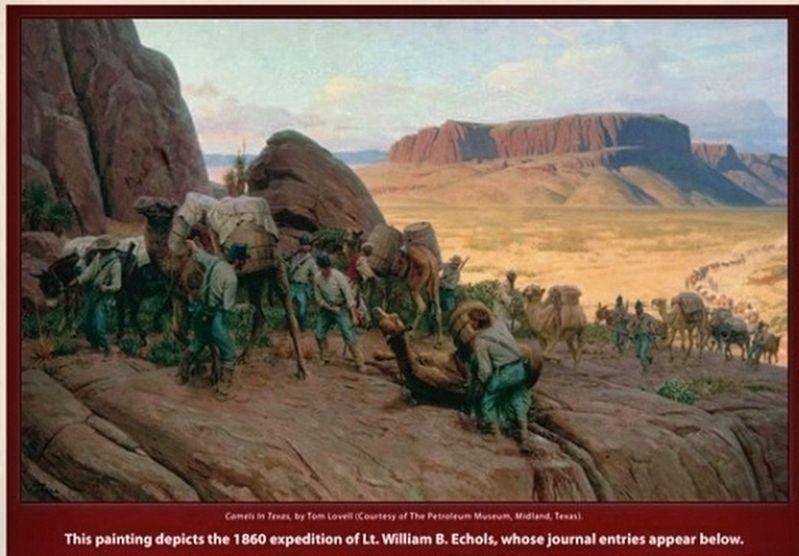
Photographed By Cosmos Mariner, June 2, 2014
2. Painting depicts the 1860 expedition of Lt. William B. Echols, whose journal entries appear below:
June 30, 1860:
“left the Pecos at camp this morning with intention of making our way across the country to Fort Davis... Whilst ascending to the Mesa two camels fell and busted two of the kegs and injured several others, wasting about forty gallons of our most appreciated loading. The animals I believe are not injured. One of them lost its foothold, fell, and pulled the others from the trail by the rope attaching the train. Others might have suffered the same fate but for the timely assistance of lieutenant Holman, who cut the lead line. During the ascent they had to resort to their feat of walking on their knees, which they do when the inclination of the trail is very great and heavily laden, to throw the center of gravity equally over the four legs, or on a sloping trail when their feet slip from under them. Marched 15.4 miles.”
July 4, 1860:
“This is the fifth day since leaving the Pecos; the men are on foot, with half allowance of water; marched 120 miles, thermometer about 100 in shade… over the most rugged country known, the last days made about thirty miles. The mules were watered only twice on half allowance and on the sixth day from water, the camels stood it well. Today, however, four mules gave out before reaching comp, two of which managed to reach camp after the command; the others abandoned. It was strange to see how eagerly they would seize a canteen whenever they were near it, and try to tear it to pieces... the men were cautioned about permitting them to drink too much at a time, as it sometimes proves fatal.”
3rd Expedition – 1860
Again in the summer of 1860, under the command of Lt. Echols, a military survey team from Camp Verde mapped the territory between the San Antonio to El Paso Road, the Rio Pecos and the Rio Grande, and much of the southwestern Big Bend area from Ft. Davis to Presidio del Norte, and Lajitas Crossing on the western Comanche Trail. Camels carried much of the food and gear and all the water, including enough for the horses and mules. The camels, however, only drank from water holes and springs, and managed to survive by eating desert plants unpalatable to horses and mules.
Topics and series. This historical marker is listed in these topic lists: Animals • Exploration. In addition, it is included in the Former U.S. Presidents: #14 Franklin Pierce series list. A significant historical year for this entry is 1856.
Location. 29° 44.574′ N, 103° 9.651′ W. Marker is near Marathon, Texas, in Brewster County. Marker is on U.S. 385, 3.7 miles north of Farm to Market Road 2627, on the left when traveling south. Marker is located in pull-out on east side of highway, about 6 miles north of Big Bend National Park's Persimmon Gap Visitor Center. Touch for map. Marker is in this post office area: Alpine TX 79830, United States of America. Touch for directions.
Other nearby markers. At least 2 other markers are within 6 miles of this marker, measured as the crow flies. Double Mills (a few steps from this marker); Comanche Trail (approx. 5.8 miles away).
Also see . . .
1. The U.S. Army's "Camel Corps" Experiment. Jefferson Davis first encouraged the Army’s use of camels while serving in the U.S. Senate. In 1855, Secretary of War Davis persuaded a skeptical Congress to appropriate $30,000 for the purchase and importation of camels for the Army. (Submitted on December 14, 2017, by Cosmos Mariner of Cape Canaveral, Florida.)
2. Camels Arrive in Texas, Begin U.S. Army Experiment (April 29, 1856). the beasts could carry substantial amounts of freight;they could go many days without taking water, but not at any great speed;they could negotiate muddy terrain that would normally halt freight wagons;the camels would eat nearly anything fed to them. This included the Texas mountain cedar and the creosote bush, two plants which no other animal would touch. However, they also had an apparently voracious appetite for oats, hay and other fodder;the creatures had a tendency to frighten horses and mules at first contact, but the animals would soon become used to one another; and, finally,their smell and unpleasant habit of spitting at anything that annoyed them did not endear them to Army personnel. (Submitted on December 15, 2017, by Cosmos Mariner of Cape Canaveral, Florida.)
3. The U.S. Camel Corps. Horses were the Army’s primary form of transport during the 19th century, but things might have been very different if not for the failure of the U.S. Camel Corps. This unlikely experiment began in 1856 after Secretary of War Jefferson Davis imported a herd of several dozen camels from North Africa and Turkey. Davis believed the “ships of the desert” would flourish in the arid climate of America’s newly acquired territories in the Southwest, and early tests and supply runs seemed to back him up. (Submitted on December 15, 2017, by Cosmos Mariner of Cape Canaveral, Florida.)
Credits. This page was last revised on December 17, 2017. It was originally submitted on December 14, 2017, by Cosmos Mariner of Cape Canaveral, Florida. This page has been viewed 475 times since then and 31 times this year. Photos: 1, 2, 3, 4, 5, 6. submitted on December 15, 2017, by Cosmos Mariner of Cape Canaveral, Florida. • Bernard Fisher was the editor who published this page.
